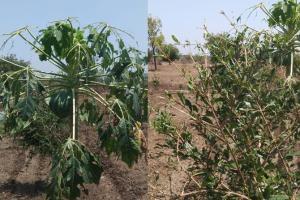Experts say they have to vanish before the onset of the monsoon or they might settle down causing more challenges for Maharashtra

Locusts attacks farms in Maharashtra. Picture courtesy/ mid-day reader
Locusts have finally entered Maharashtra after attacking north India, causing serious concerns amongst farmers and the government machinery, as these insects survive only on crops and green vegetation.
ADVERTISEMENT
While the state agriculture department has already started monitoring the movements of the locust swarms, they have estimated that approximately eight crore locusts have entered different parts of Maharashtra – including Amravati, Nagpur, destroying crops and have probably reached Bhandara district, as on Wednesday.
The concern at present is that these insects should vanish from the state before the onset of monsoon, or else experts say, they might settle down, causing more challenges.
Subhash Nagare, Divisional Joint Director Agriculture, Amravati division, informed mid-day that "On May 24 around 7 pm, we received frantic phone calls from the farmers of Pala village, Morshi Taluka, Amravati, informing about swarms of insects in their farms. A team rushed to the spot and found that the insects were desert locusts, which were never seen in Maharashtra before. Around 10 to 15 lakh locusts had come in a swarm."
Nagare added, "We sprayed Chlorpyrifos (an insecticide) in Pala village and asked farmers to make sounds by beating drums, banging thalis, making musical sounds etc, and use tractors and motorcycles without silencers so that the locusts could be compelled to move away."
Nagare said that on May 26 they found thousands of the locusts lying dead in the farms and the remaining had moved away. "We estimate that nearly eight crore locusts entered Maharashtra, of which smaller groups swarmed to different areas on May 24 night. Some returned to Madhya Pradesh and others reached Bhandara on May 27."
'Ate up any vegetation'
"Locusts usually thrive on jowar, bajra, and maize, and since these are not being cultivated in the affected areas, during swarming they settled on any vegetation and ate up the leaves of oranges, grass and seasonal vegetables etc." he said.
Nagare said that theyhave no provision for aerial spraying of insecticides and have to rely on traditional indigenous spraying methods. "Moreover, we are hopeful that they will vanish before it starts raining, or else rain and greenery will make them settle at a place, leading to breeding, which will be a bigger challenge and reason for causing heavy losses to the farmers in coming season," Nagare said.
Swarm of locusts caught on camera in Rajasthan!
— Mid Day (@mid_day) May 28, 2020
Swarms have entered Maharashtra including Amravati and Nagpur, destroying crops, the locusts are expected to reach Bhandara district, as on Wednesday.#LocustSwarmsAttack pic.twitter.com/OmKLvtODZK
Speaking to mid-day, Dr Anil Kolhe, professor of Entomology at the College of Agriculture, Nagpur said, "We do not fall under the zone of convergence for locusts, which is Iran, Afghanistan, Baluchistan, Pakistan, Rajasthan, Gujarat etc. The last we heard of locusts entering Maharashtra was almost 17 years ago."
"We are hopeful that few locusts have settled in some places as they passed through, which they usually do during the day time. According to the pre-monsoon weather conditions, we presume they will enter Bhandara and Gondia by Wednesday evening and might settle down there. Or they may proceed further towards Gondia and Chhattisgarh, in the next few days," explained Dr Kolhe.
'Locusts may be swarming'
He further added, "Our biggest concern, is that while swarming, these locusts have entered the Kamptee area of Nagpur, which is also known for the famous Kanhan and Pench and Kolar rivers. These rivers pass through vegetative areas, and might be a suitable location for the locusts for breeding. A female locust at a time can lay nearly 100 to 150 eggs, and it takes 10-12 days for the emergence of nymphal population."
Dr Kolhe said however, they have not come across any egg laying locations, so the locusts must be swarming, and should be out of Maharashtra before it starts raining.
"We have suggested to the agriculture department that the spraying of insecticides should be done through aerial means, as vast areas of the farms might have come under the swarming impact," he said.
Chemicals might harm humans
The chemicals used to keep pests such as locusts away are known to harm human beings. Dr Wiqar Shaikh, senior allergy and asthma specialist said there are two main varieties of locusts a) Locust Migratoria and b) Schistocerca gregaria. He said, "The various diseases which locusts can cause are – allergic conjunctivitis (eye allergy), allergic rhinitis (frequent cold), skin allergy (hives), Anaphylaxis (unconsciousness due to eating locusts). Allergy vaccines can be used in treating allergies due to locusts." He said using pesticides to get rid of locusts can be harmful to the elderly and pregnant women. The elderly could get severe attacks of asthma or skin rashes. In pregnant women these chemicals may harm the unborn child and develop abnormalities such as heart, brain, lung, defects etc.
Catch up on all the latest Mumbai news, crime news, current affairs, and a complete guide from food to things to do and events across Mumbai. Also download the new mid-day Android and iOS apps to get latest updates.
Mid-Day is now on Telegram. Click here to join our channel (@middayinfomedialtd) and stay updated with the latest news
 Subscribe today by clicking the link and stay updated with the latest news!" Click here!
Subscribe today by clicking the link and stay updated with the latest news!" Click here!






